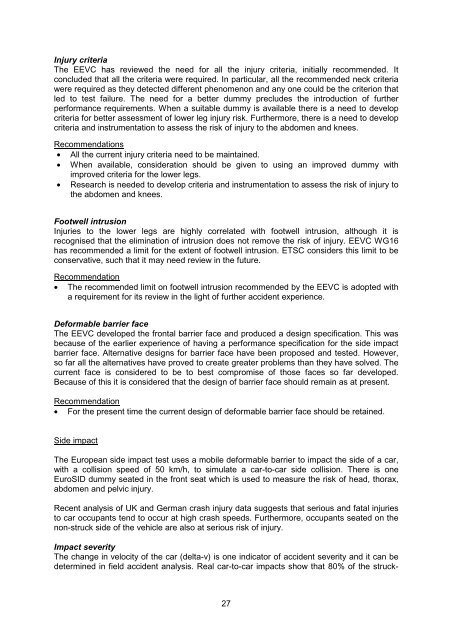PRIORITIES FOR EU MOTOR VEHICLE SAFETY DESIGN
priorities for eu motor vehicle safety design - ETSC
priorities for eu motor vehicle safety design - ETSC
You also want an ePaper? Increase the reach of your titles
YUMPU automatically turns print PDFs into web optimized ePapers that Google loves.
Injury criteria<br />
The EEVC has reviewed the need for all the injury criteria, initially recommended. It<br />
concluded that all the criteria were required. In particular, all the recommended neck criteria<br />
were required as they detected different phenomenon and any one could be the criterion that<br />
led to test failure. The need for a better dummy precludes the introduction of further<br />
performance requirements. When a suitable dummy is available there is a need to develop<br />
criteria for better assessment of lower leg injury risk. Furthermore, there is a need to develop<br />
criteria and instrumentation to assess the risk of injury to the abdomen and knees.<br />
Recommendations<br />
• All the current injury criteria need to be maintained.<br />
• When available, consideration should be given to using an improved dummy with<br />
improved criteria for the lower legs.<br />
• Research is needed to develop criteria and instrumentation to assess the risk of injury to<br />
the abdomen and knees.<br />
Footwell intrusion<br />
Injuries to the lower legs are highly correlated with footwell intrusion, although it is<br />
recognised that the elimination of intrusion does not remove the risk of injury. EEVC WG16<br />
has recommended a limit for the extent of footwell intrusion. ETSC considers this limit to be<br />
conservative, such that it may need review in the future.<br />
Recommendation<br />
• The recommended limit on footwell intrusion recommended by the EEVC is adopted with<br />
a requirement for its review in the light of further accident experience.<br />
Deformable barrier face<br />
The EEVC developed the frontal barrier face and produced a design specification. This was<br />
because of the earlier experience of having a performance specification for the side impact<br />
barrier face. Alternative designs for barrier face have been proposed and tested. However,<br />
so far all the alternatives have proved to create greater problems than they have solved. The<br />
current face is considered to be to best compromise of those faces so far developed.<br />
Because of this it is considered that the design of barrier face should remain as at present.<br />
Recommendation<br />
• For the present time the current design of deformable barrier face should be retained.<br />
Side impact<br />
The European side impact test uses a mobile deformable barrier to impact the side of a car,<br />
with a collision speed of 50 km/h, to simulate a car-to-car side collision. There is one<br />
EuroSID dummy seated in the front seat which is used to measure the risk of head, thorax,<br />
abdomen and pelvic injury.<br />
Recent analysis of UK and German crash injury data suggests that serious and fatal injuries<br />
to car occupants tend to occur at high crash speeds. Furthermore, occupants seated on the<br />
non-struck side of the vehicle are also at serious risk of injury.<br />
Impact severity<br />
The change in velocity of the car (delta-v) is one indicator of accident severity and it can be<br />
determined in field accident analysis. Real car-to-car impacts show that 80% of the struck-<br />
27



